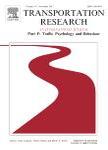版权所有:内蒙古大学图书馆 技术提供:维普资讯• 智图
内蒙古自治区呼和浩特市赛罕区大学西街235号 邮编: 010021

作者机构:Dalian Univ Technol Sch Econ & Management Dalian Peoples R China Nanchang Univ Postdoctoral Mobile Stn Management Sci & Engn Nanchang Peoples R China
出 版 物:《TRANSPORTATION RESEARCH PART F-TRAFFIC PSYCHOLOGY AND BEHAVIOUR》 (Transp. Res. Part F Traffic Psychol. Behav.)
年 卷 期:2025年第114卷
页 面:16-29页
核心收录:
学科分类:0402[教育学-心理学(可授教育学、理学学位)] 08[工学] 0823[工学-交通运输工程]
基 金:National Natural Science Foundation of China Jiangxi Provincial Key Research Base Projects in Philosophy and Social Sciences [24ZXSKJD12] Jiangxi Provincial Natural Science Foundation [20242BAB20011] Postdoctoral Fellowship Program of CPSF [GZC20231029] Humanities and Social Sciences Youth Project of the Ministry of Education [24YJC630241]
主 题:Algorithmic management Challenge-hindrance stressors Aggressive driving behavior Attentiveness Regulatory focus Ride-hailing drivers
摘 要:The rise of ride-hailing platforms has changed customers travel preferences and improved traffic efficiency. However, even though they are vital to ensuring customers safety and satisfaction, the roles of algorithmic management stressors in shaping ride-hailing drivers driving behavior are not well understood. This study draws on affective event theory to theorize how algorithmic management challenge and hindrance stressors manifest themselves in impacting aggressive driving behavior in the context of ride-hailing services. A time-lagged questionnaire survey design was used to collect data from 330 drivers working for ride-hailing services at four different time points. Latent mediation-moderation structural equation modeling was used to test the conceptual model. The results indicate that: 1) Algorithmic management challenge stressors undermine, while hindrance stressors promote, aggressive driving behavior. 2) Attentiveness mediates the indirect impacts of both algorithmic management challenge and hindrance stressors on aggressive driving behavior. 3) Promotion regulatory focus amplifies the indirect negative relationship that links algorithmic management challenge stressors through attentiveness to aggressive driving behavior. 4) Prevention regulatory focus amplifies the indirect positive relationship that links algorithmic management hindrance stressors through attentiveness to aggressive driving behavior. This study incorporates the aggressive driving behavior of ride-hailing drivers in the algorithmic era into road safety research by integrating the affective pathway of attention and drivers characteristics. The aim is to contribute to the understanding of the mechanisms and boundaries between algorithmic management stressors and aggressive driving behavior.